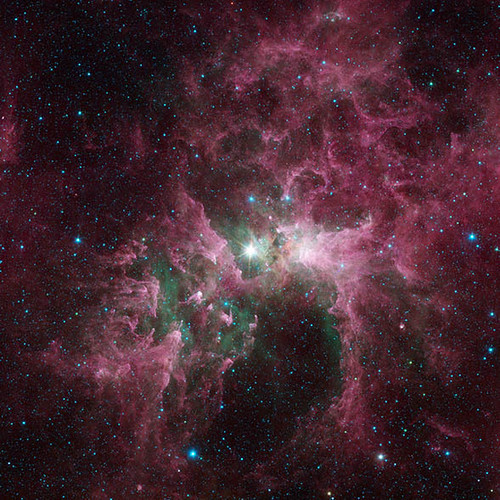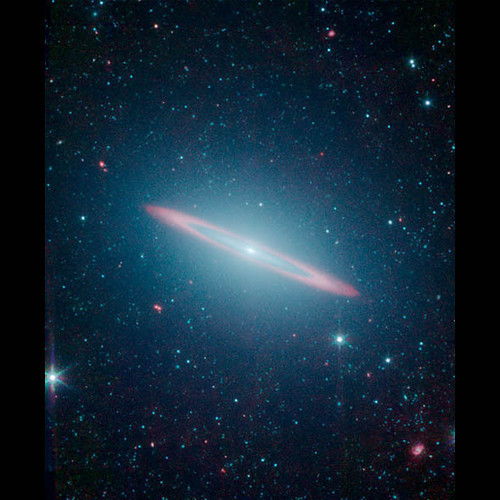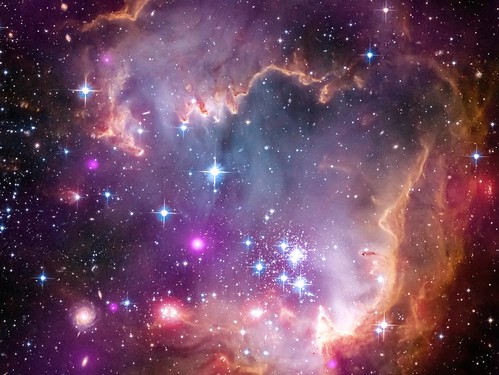Happy birthday, Spitzer!
- By Maggie Masetti
- September 6, 2013
- Comments Off on Happy birthday, Spitzer!
Seems like only yesterday we were celebrating the 5th birthday of the Fermi Gamma-ray Space Telescope. As it turns out, there’s another space telescope celebrating a big anniversary – the Spitzer Space Telescope just turned ten on August 25th! I know talk a lot about JWST and how amazing it’s going to be, but the truth is that within its lifetime Spitzer has covered the infrared part of the electromagnetic spectrum in unprecedented ways.
Recently we talked about one reason infrared astronomy is special – and that is that infrared telescopes allow you to see what is behind clouds of dust that block visible light from escaping. Here are some examples of what Spitzer has revealed to us – also proof that infrared images are just as beautiful as visible light ones!
Here’s the Carina Nebula as seen by Spitzer. The bright star at the center is Eta Carinae (actually one of the most massive stars in the galaxy), and it is shaping and sculpting the nebula that surrounds it. In this infrared image, the dust is shown in red and the clouds of hot, glowing gas appear green.

Carina Nebula, Credit: NASA/JPL-Caltech
In the below image another giant star, Zeta Ophiuchi, is creating a bow shock in front of it in the surrounding dust. The star is actually moving very quickly, and it is the stellar winds flowing out from the star that are making ripples in the dust as it approaches, something only visible in the infrared. The area of the shock is dramatic in appearance at longer infrared wavelengths (shown here as red), while the detailed, fine dust filaments around the star glow at shorter infrared wavelengths (shown in green).

Zeta Ophiuchi, Credit: NASA/JPL-Caltech
Infrared light showed that Sombrero Galaxy isn’t simply one galaxy – it has a strange duality to it. A thick disk galaxy (partly seen in red) is actually embedded within a large elliptical galaxy (blue-green). This is not something revealed by visible-light observations! This “split personality,” or spiral-elliptical duality (like the photon has wave-particle duality) gives the Sombrero Galaxy characteristics of both types of galaxy, and as such may tell us new things about galaxy formation.

Sombrero Galaxy, Credit: NASA/JPL-Caltech
A dying star is throwing off its outer layers, below – you may recognize this as the Helix Nebula. This is actually infrared and ultraviolet data. Data from GALEX (in blue) of the ultraviolet light coming from this system combines with infrared observations of the dust and gas (in yellow) from Spitzer. Beyond the nebula is more infrared data from WISE.

Helix Nebula, Credit: NASA/JPL-Caltech
As seen above, Spitzer data is also often combined with data from other observatories to create a more nuanced and complete picture. Below is a gorgeous image of part of the Small Magellanic Cloud, an irregular galaxy nearby our own. In purple is X-ray data from the Chandra X-ray Observatory. Visible light from Hubble is red, green, and blue; infrared observations from Spitzer are also in red.

Small Magellanic Cloud, Image credit: NASA/CXC/JPL-Caltech/STScI
We wish Spitzer many more happy years of infrared observations. Now we just need someone to make a cake!


